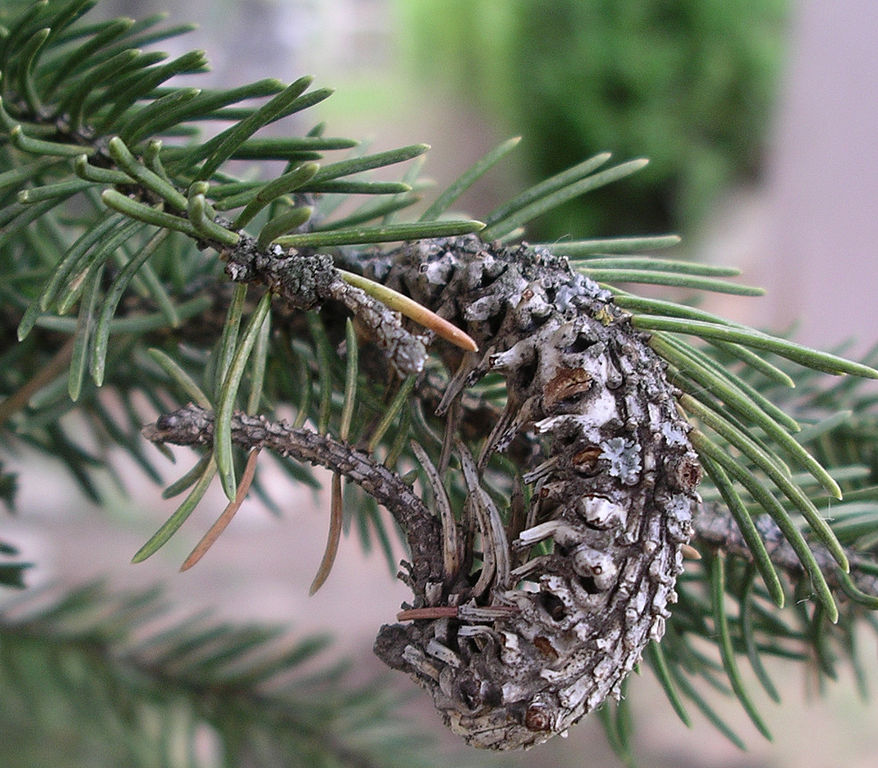Introduction
Cooley spruce gall adelgis (Adelges cooleyi) is a small black insect native to North America. The insect causes the formation of galls on several spruce trees, as well as needle distortion and discoloration on Douglas-fir. Severe infestations can deform trees, and inhibit their growth.
Distribution & Habitat
In the United States, cooley spruce gall adelgid is found across the Northeast, and Rocky Mountain states.
Hosts
The most common host plants for cooley spruce gall adelgid are Colorado blue spruce, and Douglas-fir. The pest also infests Engelmann spruce, Sitka spruce, and Oriental spruce.
Description
Cooley spruce gall adelgid is a small, black, soft-bodied insect. Females may be winged or wingless. Eggs are small and laid in masses. On Douglas-fir, the waxy masses may be observed on infested needles. The gall formed on spruces is an elongate green growth shaped like a pineapple. Galls develop on the tips of infested branches, and turn brown in late summer.
Life Cycle
Cooley spruce gall adelgid produces up to six generations per year. The insect has a complex life cycle. It infests spruce trees, and Douglas-fir, often alternating between the two. When originating on spruce, the insect must navigate to Douglas-fir to conclude its life cycle. Cooley spruce gall adelgid develops over a period of two years. Immature females overwinter at the bases of terminal buds. They become active in spring, whereupon they resume feeding. Once mature, the females lay several hunded eggs on lateral twigs. The eggs hatch in ten to fourteen days, revealing masses of young nymphs that migrate to new growth. The nymphs crawl into the expanding buds, and proceed to feed on the elongating needles. The persistent feeding of the nymphs promotes abnormal plant cell development in the buds. This encourages a gall to form, which envelops the nymphs. The nymphs continue to feed within the gall, developing within the enclosed chamber. By mid-summer, the gall turns brown, becomes desiccated, and unfolds, with the adelgids emerging onto the host. Some of the adelgids migrate to Douglas-fir, while others remain on the spruce. On Douglas-fir, the females lay eggs on the needles, producing an additional generation. The eggs hatch, and the nymphs overwinter. They mature into winged or wingless females the following spring. The wingless females remain on the Douglas-fir to reproduce. The winged females navigate to nearby spruce trees to begin the cycle anew.
Symptoms of Infestations
On spruce twigs, the feeding of the nymphs induces the formation of galls on the branch tips. When infestations are severe, the resulting bud deformation can distort the tree. Galls range from ½ an inch to three inches in diameter. Galls are initially green, but turn brown by late summer. Galls may persist for several years. Galls are not formed on Douglas-fir, but feeding by the species on the needles may cause needle discoloration, and needle distortion, with infested needles becoming bent or crooked. Infested needles often drop prematurely. As the insects feed on the needles, they secrete a substance referred to as honeydew. Sooty mold often develops on the honeydew. This causes the infested branches to assume a blackened appearance. In early spring, waxy egg masses can be observed on the underside of needles on Douglas-fir. Once the eggs hatch, the nymphs will also feed on developing cones. Significant damage to the cones can inhibit seed production.
Management
- On small spruce trees, remove and dispose of the green colored galls during June or July, prior to the adults’ emergence. This will help to limit adelgid populations.
- To manage the overwintering females, registered insecticides can be applied on spruce and Douglas-fir from mid-September to early October. Applications may also be performed in spring just prior to budbreak.
- Applications of dormant oil may be administered to control the overwintering nymphs. Applications should be performed before new growth emerges in early spring, or in early fall after the first frost has occurred.
- Encourage the development of natural predators, such as lacewings, assassin bugs, and lady beetles.
